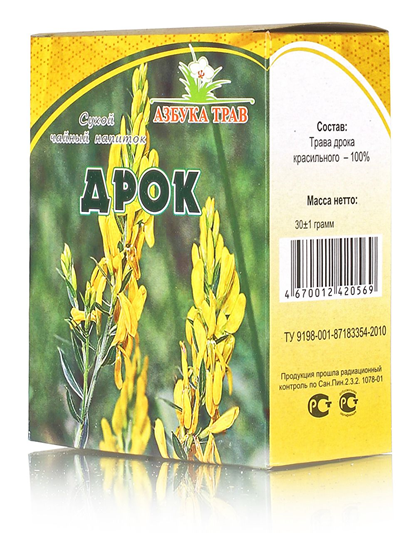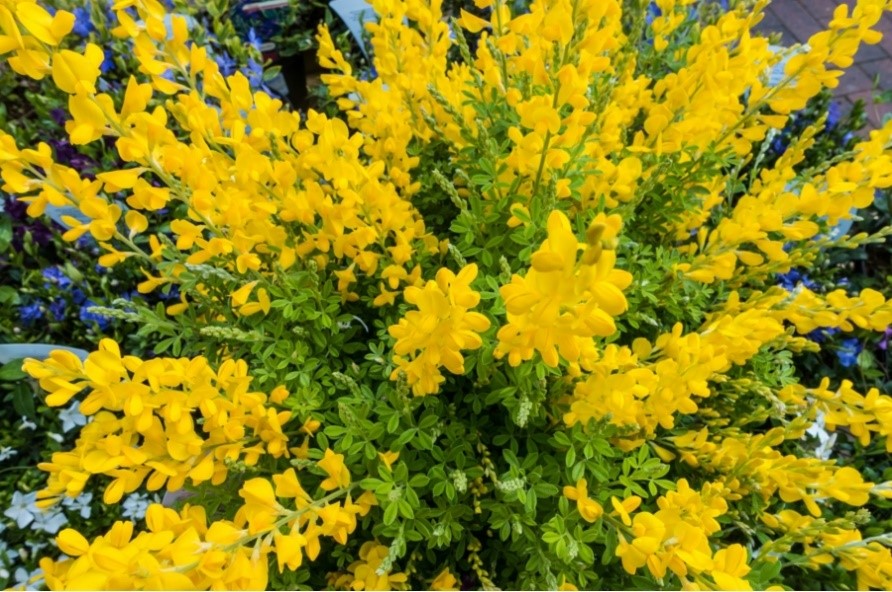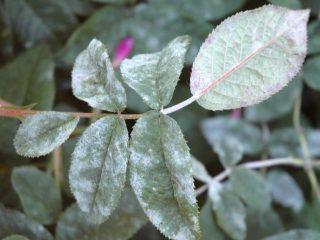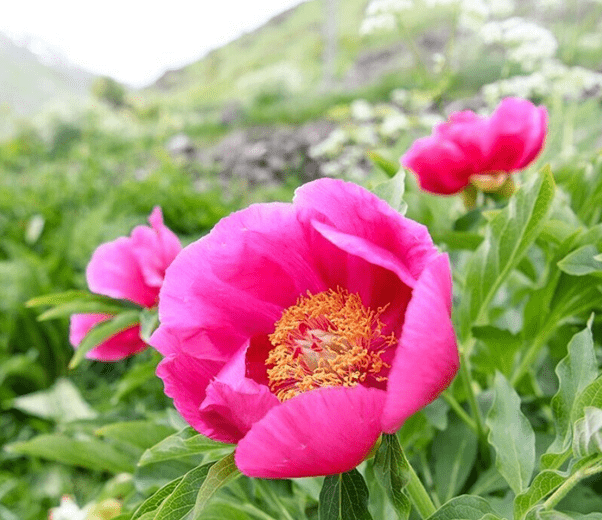Content
Plants that reproduce well by self-sowing are usually considered weeds. Gorse, although it belongs to the category of crops that can spread without human intervention, due to its high decorative qualities, is widely used in landscape design. In addition, this unique plant is successfully used in folk medicine.

Gorse is a honey plant that attracts bees and other flying insects throughout the long flowering period.
Description of gorse
The botanical name of the gorse plant is Genista tinctoria (genista tincture), which is translated from Latin as “dye’s broom.” The group includes related crops, which can differ greatly in shape, leaf color and crown configuration. Since the Middle Ages, the plant has been valued as a natural yellow dye for linen fabric and wool.
Shrubs ranging in height from 20 cm to 60 cm are either lodging or erect. The green stems of gorse are thin and weakly branched. The edge is noticeable on young shoots. Dark green ellipsoidal leaves are arranged alternately on the branches. The plate attached to the short petiole is slightly fleecy or bare. In the pre-winter period, the leaves of the plant wither and fall off.
The inflorescences are an erect or drooping raceme consisting of numerous buds. Due to branching, a kind of fluffy panicle is formed at the top of the stem. The butterfly flowers are bright yellow in color. The buds are formed on young shoots and are located one at a time in the axils. The flowering of gorse lasts almost the entire warm period: from early June to September. The fruits of the crop are flat beans that crack as they ripen. Each of them contains 8-12 seeds.

Many varieties of gorse exude a pleasant aroma that fills the space of the site
Where does gorse grow?
The distribution area of gorse is wide. The plant can be found in many regions of Russia:
- in the North Caucasus;
- in the Non-Black Earth Region;
- in the Volga region;
- in the Urals;
- in Western Siberia.
The culture feels comfortable on rocky slopes, in light deciduous forests, and pine forests. The medicinal plant prefers sandy or limestone soil, and does not take root on fertile soil.
The best varieties
There are several varieties of gorse. They differ in bush height, color, shape and size of flowers:
- Royal Gold;
Royal Gold is a fast-growing shrub 60-80 cm high, it is completely covered with golden-yellow flowers collected in dense brushes.
- prickly gorse;
The branched shoots of prickly gorse are covered with many spines, the leaf blades have a bluish tint
- Don gorse;
A perennial branched shrub of this species reaches 50 cm in height, it has lanceolate leaves and loose inflorescences
- Spanish gorse;
An adult specimen of a weakly branched shrub has a spherical crown and reaches 60 cm in height and width
- gorse;
A plant with small elliptical leaves makes the inflorescences of a bright golden hue visible
- creeping gorse (creeping).
The variety is a low shrub with dense light green foliage and yellow racemose inflorescences
Useful properties of gorse
In folk medicine, the beneficial properties of gorse have been known for a long time. But recently scientists have become interested in the plant. As a result of the research, it was possible to establish that gorse has a unique biochemical composition.
- Essential oils (up to 0.05%). The highest concentration of the substance is observed in dried inflorescences.
- Various alkaloids that determine the poisonous qualities of the plant. The highest content of toxins is present in the seeds.
- Resin acids, including succinic acid, which have antioxidant properties.
- Steroid and triterpene saponins that normalize hormonal levels and have a beneficial effect on the endocrine system.
- A complex of organic acids that regulate vital functions.
- Mineral salts necessary to maintain water balance in the body, stable functioning of the cardiovascular and urinary systems, and active brain activity.
- Antioxidants that neutralize free radicals. The result is a slowdown in the aging process, restoration of damaged cells, and provision of protection against cancer.
- Glycosides that activate metabolic processes and increase the vitality of the body.
- Tannins with regenerative and antibacterial properties.
- Bitters that stimulate the production of digestive enzymes and bile.
In addition, gorse contains a large amount of minerals (iron, potassium, manganese, silicon, phosphorus, etc.) The inflorescences contain organic pigments - genistein and luteolin, which can be used in the production of natural dyes.
Use of gorse in folk medicine
Gorse is widely used in folk medicine. Alcohol and aqueous products that have powerful therapeutic properties are prepared from plant raw materials. Infusions and decoctions of flowers and leaves are used to treat:
- hepatitis;
- dermatitis;
- cystitis;
- rheumatism;
- furunculosis;
- thyroid diseases;
- gout;
- edema of renal and cardiac etiology;
- bronchial asthma;
- diseases of the nasopharynx.
Fresh leaves and fruits are used to eliminate calluses and warts. The root of the plant helps with salt diathesis and constipation.

For therapeutic purposes, gorse is used either alone or in combination with other herbs.
For the treatment of joints
The plant is used to make a homemade ointment that helps with rheumatism and other joint diseases. The product is prepared as follows:
- 200 g of pork fat is melted in a water bath.
- Pour 3 tbsp into the liquid base. l. dry plant materials.
- Heat the components over low heat for 30 minutes.
- The composition is filtered and poured into a storage container.
The cooled ointment is placed in the refrigerator. It is recommended to use the product 2-3 times a day.
For cystitis
Gorse has pronounced anti-inflammatory properties. This quality justifies the use of the plant for the treatment of cystitis. For inflammation of the genitourinary system, a herbal mixture is used.
- Mix gorse, hop cones, yarrow and oregano. Why take 20 g of each component.
- 1 tbsp. l. The mixture is poured into a glass and poured with boiling water.
- Leave the solution covered for 1 hour.
The resulting drug is taken 15 ml 4-5 times a day, washed down with water. In case of pain due to cystitis, the remedy is added to medicinal baths.
For prostatitis
To treat prostatitis, an infusion of medicinal herbs is used. The product is prepared in accordance with the algorithm:
- Mix 10 g of gorse flowers, 5 g of bearberry, 5 g of horsetail and pour into a thermos.
- The raw materials are poured with 600 ml of boiling water.
- Leave the composition under the closed lid for 5-6 hours.
The infused mixture is carefully filtered. The drug should be taken on an empty stomach, morning and evening. Single dose – 2 tbsp. l.
For otitis
Alcohol tincture of gorse is an effective remedy for the treatment of purulent otitis media. The drug relieves inflammation by destroying pathogenic microflora. The dosage form is prepared as follows:
- Pour 2 tbsp into a glass vessel. l. raw materials.
- Pour 100 ml of medical alcohol (70%) into the herb.
- The vessel is removed for two weeks in a dark place.
- The composition is filtered.
Treatment with tincture can be carried out in the early stages of the disease. Before use, the ear canals are carefully cleaned with cotton swabs soaked in hydrogen peroxide. Instill one drop of the drug. The procedure is repeated three times a day.

At night, place a tampon soaked in tincture in the sore ear.
For diabetes
It has been established that gorse reduces blood sugar. This property is used in the treatment of diabetes. The plant infusion is prepared as follows:
- The flowers are poured into the pan.
- The raw materials are poured with 300 ml of boiling water.
- Boil the liquid over low heat for five minutes.
The infusion is kept covered for an hour. The sugar-lowering agent is taken three times a day, 100 ml.
Types of healing compounds
Leaves and flowers of gorse are used as raw materials in the manufacture of medicinal compositions. The collection is organized from mid-June to the end of July. The raw materials are dried under a canopy outdoors or indoors. Plants are placed in craft bags or glass jars.
The roots of gorse are dug up in the second half of September. It is at this time that the concentration of useful substances in the underground part reaches its maximum. The roots are shaken off the ground, washed, dried in an oven (dehydrator) at a temperature of +50 0C. Store the workpieces in a dry, cool place.

A ready-to-use collection of gorse can be purchased at the pharmacy in prepackaged form.
Infusion of gorse
To prepare the infusion of gorse, you will need 1 tbsp. l. herbs. The raw materials are brewed with 450 ml of boiling water. The product is infused for at least two hours. The strained infusion is taken three times a day, 1 tbsp. l.
Tincture of gorse
To prepare the tincture, pour 50 g of inflorescences into 0.5 liters of vodka. Leave the drug unopened for a week. The infused product is used as a lotion.
Decoction
To prepare a decoction of gorse, take 15 g of crushed herbs and flowers and add 500 ml of boiling water. The composition is boiled in a steam bath until 1/3 of the original volume remains. The decoction is filtered and taken every other day. Recommended dosage – 2 tbsp. l. every two hours. The product has a laxative, diuretic and choleretic effect.
Contraindications for use
Gorse is included in the category of poisonous plants. In this regard, medicines based on it should be taken strictly following the dosage. If used incorrectly, signs of poisoning may appear:
- nausea;
- vomit;
- headache;
- dizziness;
- increased blood pressure;
- arrhythmia;
- cyanosis of the extremities.
There are contraindications to the use of gorse. The plant should not be used to treat:
- children under 12 years old;
- pregnant and lactating women;
- hypertensive patients;
- patients with ischemia;
- people with severe liver pathologies.
There have been cases of individual intolerance to dosage forms based on gorse. It is necessary to use herbal remedies only after consultation with your doctor.
Features of cultivation
Even novice gardeners can grow gorse. After planting, the plant needs regular care, but adult specimens grow well without additional agrotechnical procedures. Caring for young bushes includes:
- watering (the soil must be moderately moist);
- mulching to prevent the growth of weeds;
- shelter for the winter.
The plant does not need additional feeding and grows well on infertile lands. Excess moisture can lead to crop disease. Excess calcium in the soil is the cause of chlorosis, leading to yellowing of foliage and loss of decorative qualities.
Gorse in landscape design
Gorse is widely used in landscape design. The plant can become a striking element of a park or garden plot.

Often the crop is planted in abandoned areas of the garden, where the soil is infertile.
Low bushes fit perfectly into rock gardens and rockeries, at the same time strengthening the soil of the embankment with their branched root system. Experienced gardeners form beautiful mixborders from plants.

Wide bushes make eye-catching compositions with richly colored flowers
Companion plants can be either short (alpine poppy, begonia, matthiola, zinnia, etc.) or tall (delphinium, lupine, phlox). An excellent landscape solution is to plant gorse with other perennial bushes - yew, juniper, barberry.

With proper care and high-quality pruning, gorse will please those around you with lush flowering for many years.
Conclusion
Gorse is a medicinal crop used in the treatment of many diseases. But despite all the beneficial qualities, the plant has a number of limitations and contraindications for use. In addition, a low-growing branched shrub with bright yellow flowers is a wonderful element of landscape design.
Reviews of gorse














